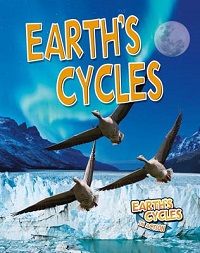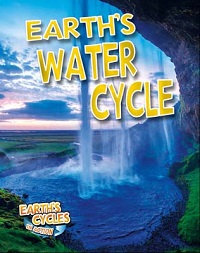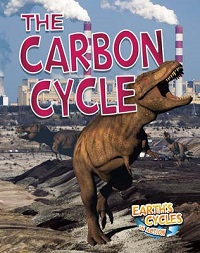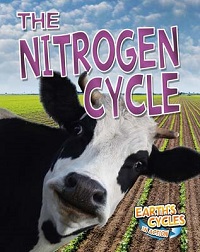| ________________
CM . . .
. Volume XXI Number 35. . . .May 15, 2015
excerpts:
Cycles are ubiquitous on Earth, and this is a fact that Diane Dakers makes clear in her “Earth’s Cycles in Action” series for Crabtree Publishing Company. She suggests that many of these cycles occur “so regularly and constantly” that we seldom think about them. Within this group are the observable cycles that include the cycle of day and night, the cycle of the seasons, the phases of the moon, the water cycle, and weather cycles that result in warm/hot summers and cool/cold winters in Canada and other parts of the Northern Hemisphere. In addition to these cycles driven by the motions of Earth relative to the Sun and Moon, there are many more cycles occurring on Earth that can’t be seen with the naked eye. These sub-microscopic cycles involve the recycling of elements, the building blocks of every non-living and living thing on Earth. Since matter can’t be created or destroyed, it must recycle. Plants and animals and other organisms without the continuous cycling of elements like nitrogen, carbon, hydrogen, and oxygen would not survive. This is the first big idea that Dakers helps adolescent and teenaged readers to understand. The second big idea is that the cycling of natural elements from air to soil to animals, or from air to plants to animals, and back to the soil and the air is in perfect balance, or has been until the most recent one hundred years. The large and growing human population and the way we live on the planet is “harming the atmosphere”, “polluting water”, “disrupting the nitrogen cycle”, and “throwing the carbon cycle dangerously out of balance”. The consequences of these actions are a thinning of the ozone layer, unusual weather patterns, climate change, thermal pollution of Earth’s oceans, melting of the polar ice caps, algae blooms, acid rain, nitric oxide smog, water scarcity, contaminated drinking water, and water-related illnesses. Given this ominous state of the planet, Dakers’ third big idea is one of hope. She describes many of the projects scientists and engineers are working on to undo the harm that has been done to the atmosphere, soil, waterways, oceans and lakes. These include tidal power and other renewable energy sources, airplanes that run on solar power and trains that run on magnetic force, water purification systems that kill harmful bacteria and clean sewage and industrial wastewater, fog nets that capture water droplets, desalination of the ocean’s water, and the sequestering of CO2 underground. In Earth’s Water Cycle, The Carbon Cycle and The Nitrogen Cycle, Dakers also provides readers with well-considered lists of changes they can make to reduce their carbon footprint, to help the nitrogen cycle stay in balance, and to reduce the volume of water used each day. The 48 pages of each book in the “Earth’s Cycles in Action” series are divided into six or seven chapters. Each chapter contains at least one stock photograph or diagram per page and several types of text boxes that are carefully positioned around the main text. Some of these text boxes are used to describe what is pictured in each image, others present information that supplements the information in the text. Those that I appreciated most were the text boxes titled “Making Sense of Cycles”. They provided an opportunity for readers to slow down and think about the presented information in order to make sense of it, to process it more deeply, or to search for supporting evidence to respond to a question or statement using the information in the preceding pages of the text. As one example, in Earth’s Cycles Dakers writes, “Think of the way the Moon affects Earth. Now imagine Earth without its Moon. What kinds of things would change? How would life be different? In what way do you think things might not be affected at all? Use information from the book to explain your thinking.” These are beautiful thought problems that require readers to think like a scientist and to use what they know and understand to provide a valid, evidence-supported answer. In addition to the well-informed content and presentation, Dakers also includes two pages near the end of the book - just before the glossary, lists of relevant books and websites, and index - that she titles “Do It Yourself”. In The Water Cycle, The Nitrogen Cycle, and The Carbon Cycle, the suggested activity and challenge is the creation and investigation of a water cycle in plastic self-sealing bag, the impact of nitrogen fertilizer on plant growth, and the decomposition of plant material by microorganisms in soil, respectively. The activity suggested in Earth’s Cycles is an internet research project that has readers looking at the impact of the location (latitude) of eight North American communities on the length of the period of daylight on June 21st (summer solstice) and December 21st (winter solstice). The challenge goes beyond determining which community has the longest and shortest days and encourages readers to look for patterns in the data and, once identified, to make predictions about the length of daylight in locations south of the southern most community for which data was recorded. As with the “Making Sense of Cycles” text boxes, Dakers is inviting readers to carry out the experimental work and research of scientists. Given the information she has made available in the preceding pages, they will have the knowledge and understanding to meet the challenges she has established. Highly Recommended.
Barbara McMillan is a teacher educator and a professor of science education in the Faculty of Education, the University of Manitoba.
To comment on this title or this review, send mail to cm@umanitoba.ca.
Copyright © the Manitoba Library Association. Reproduction for personal use is permitted only if this copyright notice is maintained. Any
other reproduction is prohibited without permission.
CM Home |
Next Review |
(Table of Contents for This Issue - May 15, 2015.)
| Back Issues | Search | CM Archive
| Profiles Archive |



